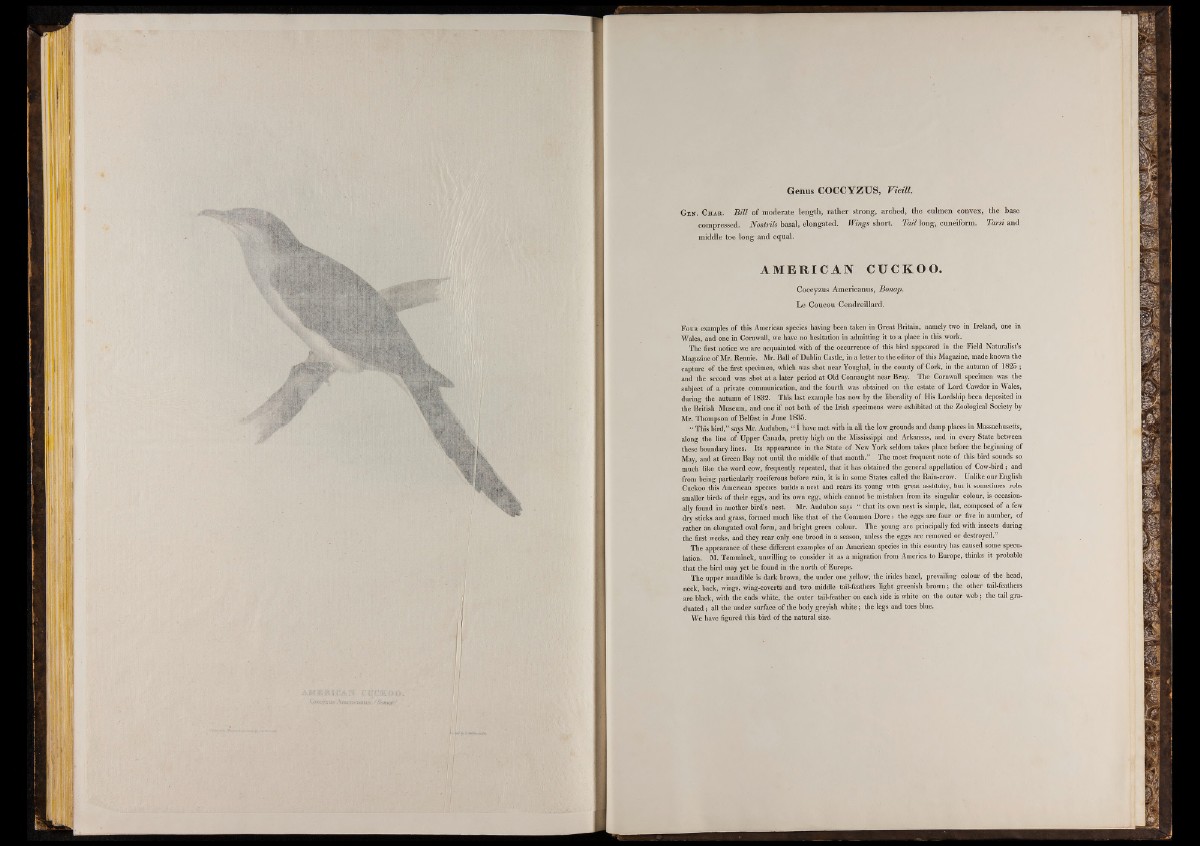
Genus COCCYZUS, Vieill.
Gen. C h a r . B i l l of moderate length, rather strong, arched, the culmen convex, the hase
compressed. N o s tr ils basal, elongated. W ings short. T a il long, cuneiform. Tarsi and
middle toe long and equal.
AME R IC A N CUCKOO.
Coccyzus Americanus, B o n a p .
L e Co u co u C en d re illa rd .
Four examples of this American species having been taken in Great Britain, namely two in Ireland, one in
Wales, and one in Cornwall, we have no hesitation in admitting it to a place in this work.
The first notice we are acquainted with of the occurrence of this bird appeared in the Field Naturalist’s
Magazine of Mr. Rennie. Mr. Ball of Dublin Castle, in a letter to the editor of this Magazine, made known the
capture of the first specimen, which was shot near Youghal, in the county o f Cork, in the autumn of 1825 ;
and the second was shot at a later period at Old Connaught near Bray. The Cornwall specimen was the
subject of a private communication, and the fourth was obtained on the estate of Lord Cawdor in Wales,
during the autumn of 1832. This last example has now by the liberality of His Lordship been deposited in
the British Museum, and one if not both of the Irish specimens were exhibited at the Zoological Society by
Mr. Thompson of Belfast in June 1835.
“ This bird,” says Mr. Audubon, “ I have met with in all the low grounds and damp places in Massachusetts,
along the line of Upper Canada, pretty high on the Mississippi and Arkansas, and in every State between
these boundary lines. Its appearance in the State of New York seldom takes place before the beginning of
May, and at Green Bay not until the middle of that month.” The most frequent note of this bird sounds so
much like the word cow, frequently repeated, that it has obtained the general appellation o f Cow-bird ; and
from being particularly vociferous before rain, it is in some States called the Rain-crow. Unlike our English
Cuckoo this American species builds a nest and rears its young with great assiduity, but it sometimes robs
smaller birds of their eggs, and its own egg, which cannot be mistaken from its singular colour, is occasionally
found in another bird’s nest. Mr. Audubon says “ that its own nest is simple, flat, composed of a few
dry sticks and grass, formed much like that of the Common Dove : the eggs are four or five in number, of
rather an elongated oval form, and bright green colour. The young are principally fed with insects during.
the first weeks, and they rear only one brood in a season, unless the eggs are removed or destroyed.”
The appearance of these different examples of an American species in this country has caused some speculation.
M. Temminck, unwilling to consider it as a migration from America to Europe, thinks it probable
that the bird may yet be found in the north o f Europe.
The upper mandible is dark brown, the under one yellow, the irides hazel, prevailing colour of the head,
neck, back, wings, wing-coverts and two middle tail-feathers light greenish brown; the other tail-feathers
are black, with the ends white, the outer tail-feather on each side is white on the outer web; the tail graduated
; all the under surface of the body greyish white; the legs and toes blue.
We have figured this bird of the natural size.